Contents
- 1 How to grow apricot tree
- 1.1 Apricot tree. Irrigation
- 1.2 Apricot tree. Uses
- 1.3 Apricot tree. Climate and location
- 1.4 Apricot tree. Reproduction, pruning, thinning and picking of fruits
- 1.5 Splinter sprung graft (graft or graft sprung from chip-chip)
- 1.6 Shield graft (T-graft)
- 1.7 The apricot tree pruning
- 1.8 “Fan” pruning
- 1.9 Planting distance
- 1.10 Thinning of the fruit
- 1.11 Pollination
- 1.12 Fruit harvest
- 1.13 Apricots. Soil and fertilizers
How to grow apricot tree


Apricot tree. Irrigation
The well rooted apricot trees do not need to be watered unless during very dry periods; they resist moderate periods of drought. Under rough drought circumstances, they can drop their buds.
The apricot trees need to be watered until they are well established. During the first year after planting it is important to water thoroughly.
![]()
Apricot tree. Uses
It is cultivated for its fruits, apricots.
![]()
Apricot tree. Climate and location
Apricots need a very specific climate to grow and produce fruit properly. Although it is a deciduous tree that requires a period of cold in winter (between about 300 and about 900 hours of temperatures below 7 º C, depending on the variety), being a tree that blooms very early (between the months of March and April, before the birth of the leaves) is very sensitive to late last winter or spring frosts.
It prefers the warmer climates where it can be grown as a normal tree or shrub in a sunny location, sheltered from cold winds. The Mediterranean climate is ideal for this plant, it provides enough cold in winter so it can develop normally and the infrequency of frost in late winter or early spring makes this plant to keep the flower in most seasons.
In the cooler climates it can be grown under cover or grow through “fan art”, which means attaching the plant to a wall with the lateral branches wide apart and with enough space between them, while the central branches are removed. In this way the plant can take heat and radiation given off by the reflection of sunlight on the wall.
Depending on the climate, we will choose the variety that interest us most. It is best to consult the nursery what kind of pattern will suit us best. (More information on varieties of apricot)
![]()
Apricot tree. Reproduction, pruning, thinning and picking of fruits
The best way to play an apricot tree is through a graft in the spring on a A plum, peach or almond St Julian pattern (we call “pattern” a well rooted tree with a diameter of 1 cm), using techniques known as Splinter sprung graft or graft canopy.
Splinter sprung graft (graft or graft sprung from chip-chip)
a) Cut a piece of new branch of apricot. Cut 2 cm below a bud and 5 cm above. Make a horizontal cut into the yolk to about 5 mm in depth so that we can separate it from the branch and it is the bud and the cambium in perfect condition. (In the form of plate, splinter or chip)
b) Cut horizontally and down a piece of bark pattern similar in size to the previously separated so that the cambium of the pattern is exposed. Leave a small portion of lower crust without separating to serve as a subject. To link the cambium of the bud is initially cut with apricot standard cambium and tighten both surfaces using adhesive tape or raffia.
When we realize that the graft has grabbed it and begins to thicken, we can remove the binding material. By the winter pattern is cut above the graft. Growth occurs from the second summer having grafted.
Shield graft (T-graft)
a) Perform the same steps showed in “a” splinter graft.
b) Make a cut in a “T” in the pattern to reach the cambium. Open the two vertical sides of the T without breaking it. Place the yolks produced in step “a” and close the T to the maximum covering the bud. Cover with ribbon or raffia. Remove material binding when both parties hold onto what usually happens within two weeks. Cut the pattern over the graft in winter.
The apricot tree pruning
The apricot tree pruning is necessary to produce abundant fruit because they grow on the young branches produced in the previous season. To stimulate growth is necessary pruning of branches in a worse state or old branches, branches that are too close together or crossed.
In well-established trees need pruning to make a spring as the buds are still closed in which the lateral branches are cut and sublaterales by 50% to stimulate new growth of young branches.
By summer pruning is done flowering branches so as to eliminate a quarter of them until the outbreak. Those branches of new growth or directed downward toward the interior must be removed.
“Fan” pruning
It is done in cold weather the trees planted on a wall. What is done is going to guide the tree on this surface using rods on which are tied and head branches. To begin the guidance, you should leave the two side branches of the young plant located about 30 cm wide open ground at an angle of 40º.
These branches are pruned leaving behind the 4th cm in length. It eliminates the central branch branch or vertical guide so that it is a plant with two lateral branches wide apart and a center well clear.
From here on each of the side branches will guide a pair of pins at an angle of 40 degrees and the rest are eliminated. In subsequent summers go setting up a structure with ribs side arms always removing branches that grow downward or toward the wall.
Planting distance
Trees as a shrub reproduced from plants should be planted at a distance of 5 to 8 meters between them and the other rows should be 8 meters away.
Trees propagated in a fan should distance between them about 4 or 5 feet, leaving the same space for rows.
Thinning of the fruit
The role of fruit thinning is to remove excess thereof that may produce fruits of sufficient quality and size. Usually what you do is first necessary to remove the fruit from each group so that they are only 3. Later re-letting interdry between a fruit and other are about 10 cm apart.
Pollination
Most varieties are self-pollinators so do not need human intervention and there is no need to use different varieties or different feet. The bee is the main insect pollinator. In colder climates may be necessary to use a brush to make a manual pollination.
Fruit harvest
The fruits should be collected a couple of days before full maturity. It is necessary to eat them after they are collected. The excedent can be frozen or dried. They keep fresh for a short time.
Apricots. Soil and fertilizers
The preferred substrate for this plant is the deep soil with good drainage of alkaline nature. Sandy soils does not support or too matted, because the lack of drainage causes them rot in the roots. In the wild they grow on dry hillsides, rocky and with a steep slope.
They do not need a particular substrate and prefer those poorer soils to rich ones.
![]() More information about apricots.
More information about apricots.








